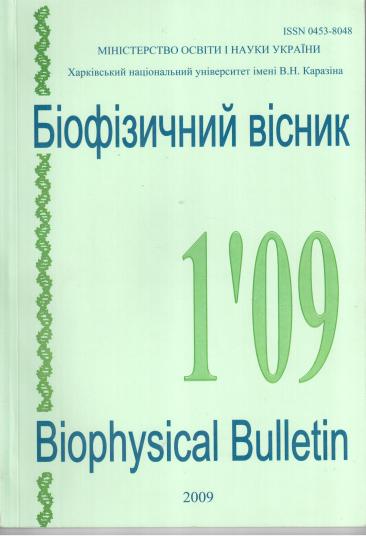Ліпосомні склади протипухлинних препаратів. ІІ. Вплив ліпідних композицій на мембранні взаємодії координаційних комплексів європію
Анотація
В даний час зростає інтерес до пошуку нових ліків, здатних ефективно руйнувати ракові клітини, не пошкоджуючи тканини здоров'я. У цьому контексті широко досліджується потенціал ліпосом як системи-носія лікарського засобу [1-3]. Ліпосоми - це частинки нанометрового розміру, в яких ліпідний бішар оточує водний внутрішній відсік. Розмір, заряд і поверхневі властивості ліпосом можна легко змінити, просто додавши нові інгредієнти в ліпідну суміш перед приготуванням ліпосом або змінивши методики приготування. Іншою важливою особливістю є те, що ліпідні везикули можуть захоплювати як гідрофільні, так і гідрофобні фармацевтичні агенти. Системи доставки ліпосом можуть підвищувати розчинність ліків, відбувається зниження токсичності, пов'язану з вільними протираковими лікарськими засобами, і підвищувати стабільність лікарського засобу, захищаючи з'єднання від хімічного розкладання або трансформації. Однак терапевтичні та токсичні ефекти лікарського засобу багато в чому визначаються ступенем або ефективністю його завантаження в ліпосоми. З цієї причини при використанні ліпосом в якості систем доставки гідрофобних лікарських засобів необхідно знати характер впливу лікарського засобу на структуру і фізико-хімічні властивості ліпідного бішару. Метою даної роботи було вивчити вплив ліпідного складу на мембранні взаємодії координаційних комплексів європію, V3 і V4, потенційних протипухлинних препаратів. Ліпосоми були утворені фосфатидилхолін яєчного жовтка (PC) і його сумішшю з кардіоліпіну (CL) і бромідом цетилтриметиламоній (CTAB). Мембранні властивості досліджуваних препаратів оцінювали з використанням методу рівноважного діалізу в поєднанні з абсорбційної спектроскопией. Щоб отримати уявлення про вплив ліків на фізичні параметри і молекулярну організацію ліпідного бішару, були використані два флуоресцентних зонда, а саме. пірен і 1,6-дифеніл-1,3,5-гексатріен (DPH). Було виявлено, що включення анионного липида кардіоліпіну та катіонного детергенту CTAB в бислой ПК призводить до зниження коефіцієнтів розподілу ліків. Впровадження препарату в ліпосомальна мембрану супроводжується зміною спектральних параметрів пірену і анізотропії DPH. Спостережувані ефекти дозволяють припустити, що вплив сполук європію на структурний стан бішару може модулюватися CL і CTAB.
Завантаження
Посилання
REFERENCES
Allen. T. Liposomal drug formulations. Rationale for development and what we can expect
for the future // Drugs. – 1998. – V. 56. – P. 747-756.
Cavalcanti L., Konovalov O., Torriani I. Lipid model membranes for drug interaction
study // Eur. Biophys. J. – 2006. – V. 35. – P. 431-438.
Drummond D. et al. Optimizing liposomes for delivery of chemotherapeutic agents to solid
tumors // Pharm. Rev. – 1999. – V. 51. – P. 691-743.
Momekov G. et al. Evaluation of the cytotoxic and pro-apoptotic activities of Eu(III)
complexes with appended DNA intercalators in a panel of human malignant cell lines //
Med. Chem. – 2006. – V. 2. – P. 439-445.
Mui B. et al. Extrusion technique to generate liposomes of defined size // Meth. Enzymol. – 2003. – V. 367.
– P. 3-14.
Bartlett G. Phosphorus assay in column chromatography // J. Biol. Chem. – 1959. – V.
– P. 466-468.
Ladokhin A.S. et al. Bilayer interactions of indolecidin, a small antimicrobial peptide rich
in tryptophan, proline, and basic amino acids // Biophys. J. – 1997. – V. 72. – P. 794-805.
Word R.C. et al. Partitioning of tetrachlorophenol into lipid bilayers and sarcoplasmic reticulum: Effect of length of acyl chains, carbonyl group of lipids and biomembrane structure // J. Membr. Biol. – 2005. – V. 203.
– P. 127-142.
Ioffe V. M. et al. A new fluorescent squaraine probe for the measurement of membrane
polarity // J. Fluoresc. – 2006. – V. 16. – P. 47-52.
Yudintsev A.V. et al. Liposomal formulations of antitumor drugs. I. Cholesterol effect on membrane interactions of europium coordination complexes // Biophys. Bull. – 2008. – V. 21 (2). – P. 64-67.
Ioffe V., Gorbenko G.P. Lysozyme effect on structural state of model membranes as revealed by pyrene excimerization studies // Biophys. Chem. – 2005. – V. 114. – P. 199-204
Автори, які публікуються у цьому журналі, погоджуються з наступними умовами:
- Автори залишають за собою право на авторство своєї роботи та передають журналу право першої публікації цієї роботи на умовах ліцензії Creative Commons Attribution License, котра дозволяє іншим особам вільно розповсюджувати опубліковану роботу з обов'язковим посиланням на авторів оригінальної роботи та першу публікацію роботи у цьому журналі.
- Автори мають право укладати самостійні додаткові угоди щодо неексклюзивного розповсюдження роботи у тому вигляді, в якому вона була опублікована цим журналом (наприклад, розміщувати роботу в електронному сховищі установи або публікувати у складі монографії), за умови збереження посилання на першу публікацію роботи у цьому журналі.
- Політика журналу дозволяє і заохочує розміщення авторами в мережі Інтернет (наприклад, у сховищах установ або на особистих веб-сайтах) рукопису роботи, як до подання цього рукопису до редакції, так і під час його редакційного опрацювання, оскільки це сприяє виникненню продуктивної наукової дискусії та позитивно позначається на оперативності та динаміці цитування опублікованої роботи (див. The Effect of Open Access).





